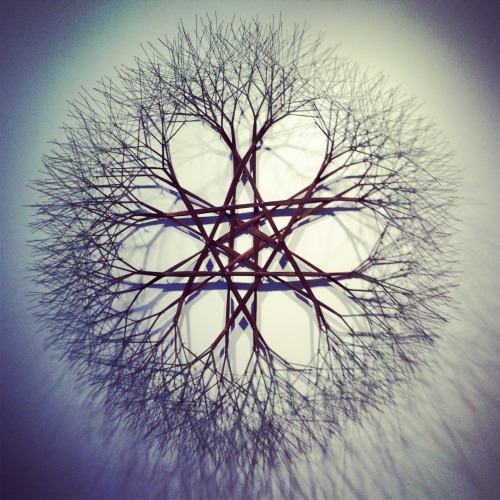
December 30, 2013
“Year of the Woman” Revisited: Alexandra Lange on Criticism, Mentorship, and Memory
In this intimate 2013 reflection, Pulitzer Prize–winning critic Alexandra Lange names her heroines, honors her mentors, and charts the beginnings of her voice in design criticism.

A wall sculpture by Ruth Asawa from her Christie’s exhibition this spring. A reminder to be thorny.
Editor’s Note: We’re proud to resurface this short yet powerful essay from longtime Design Observer contributor Alexandra Lange, written more than a decade before she won the 2025 Pulitzer Prize for Criticism. In it, she reflects on the women who shaped her thinking, the state of gender equity in design, and the role of trust in her creative process, particularly from our founding Editorial Director, Bill Drenttel. Her closing words on mentorship and autonomy still resonate today, and offer a glimpse of the clarity, integrity, and compassion that now define her work.
As the year-end and best-of lists rain down, I have been thinking of my own highlight reel. For me it was a year of women. Maybe I was finally old enough to embrace the perspective that comes with my gender, or maybe it happened to be the year when a lot of other people started counting the number of women in architecture, in design, in technology, and in the media, on panels, in the history books, on editorial pages. I’ve always believed that you have to choose your own heroines. This year I made imaginary mentors out of a few new ones, as well as finally writing something personal about the woman that inspired me to be an architecture critic in the first place. Ten stories circling that theme.
Ada Louise, I miss you.
On Ada Louise Huxtable: a personal history, and a critic’s assessment.
On Mariana Van Rensselaer, the mother of us all.
On the relation of craft to design, through fictional characters like Bernadette Fox, through the history of making in California, and through the better-than-fiction career of sculptor Ruth Asawa, memorialized by Robert Sullivan in this weekend’s New York Times Magazine‘s “Lives They Lived” issue.
On the relation of children to design, and not replicating sexist patterns in the world of apps.
On the Pritzker Prize controvery, and how we can make the movement toward equality for women in architecture more than a 2013 meme. Is giving the first AIA Gold Medal to a women enough? No, and certainly not when she’s been dead for 56 years.
Last but certainly not least, I am so saddened by the death of Bill Drenttel. Though I have often wished for hands-on mentors, for me Bill was a model of the hands-off type. I was thrilled when he asked me to join Design Observer as a contributing writer, and shocked when he said I could publish at will. No editing, no back-and-forth. As with the women critics of yore, Design Observer was a club that I had long wanted to be part of, and there he was, urging me to use my judgement about what to write and how to write it. As a result, we only met or spoke perhaps a dozen times, now a significant regret. Reading the tributes by those who knew him better, I see this brief, laser focus on what I could do (and do for the blog) was how he was able to accomplish so much. Trust is a gift, and I wished I had thanked him for it sooner.
Read more from Alexandra Lane on why Criticism = Love, what it means to be Not Afraid of Noise in Mexico City, and why sometimes it’s okay to Nevermind the Masterpiece. You can explore her full archive on Design Observer here.
Observed
View all
Observed
By Alexandra Lange
Related Posts

Graphic Design
Sarah Gephart|Essays
A new alphabet for a shared lived experience

Arts + Culture
Nila Rezaei|Essays
“Dear mother, I made us a seat”: a Mother’s Day tribute to the women of Iran

The Observatory
Ellen McGirt|Books
Parable of the Redesigner

Arts + Culture
Jessica Helfand|Essays
Véronique Vienne : A Remembrance
Recent Posts
Beauty queenpin: ‘Deli Boys’ makeup head Nesrin Ismail on cosmetics as masks and mirrors Compassionate Design, Career Advice and Leaving 18F with Designer Ethan Marcotte Mine the $3.1T gap: Workplace gender equity is a growth imperative in an era of uncertainty A new alphabet for a shared lived experienceRelated Posts

Graphic Design
Sarah Gephart|Essays
A new alphabet for a shared lived experience

Arts + Culture
Nila Rezaei|Essays
“Dear mother, I made us a seat”: a Mother’s Day tribute to the women of Iran

The Observatory
Ellen McGirt|Books
Parable of the Redesigner

Arts + Culture
Jessica Helfand|Essays
